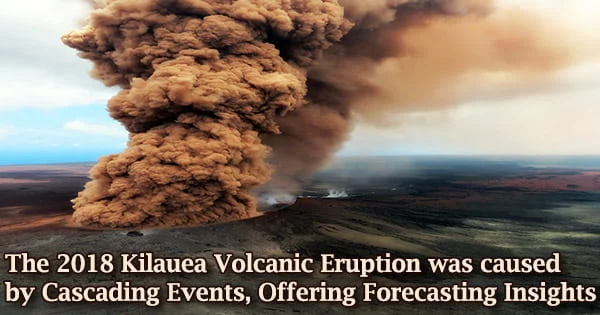One of Hawaii’s most significant volcanic eruptions in the past 200 years was the Klauea Volcano eruption in 2018. According to a recent study by earth scientists from the University of Hawai’i (UH) at Manoa and U.S. Geological Survey published in Nature Communications, this eruption was caused by a relatively small and quick change at the volcano after a decade-long build-up of pressure in the upper parts of the volcano (USGS).
A volcano is an opening or rupture in the surface of the earth through which gases, volcanic ash, and hot liquid or semi-liquid rock can escape. They often develop when tectonic plates collide or diverge, but volcanic hotspots can also cause them to form in the midst of plates
The research team recreated the geologic events using USGS Hawaiian Volcanoes Observatory (HVO) data from before and during the 2018 eruptions at the summit and flank.
“The data suggest that a backup in the magma plumbing system at the long-lived Puʻu ʻŌʻō eruption site caused widespread pressurization in the volcano, driving magma into the lower flank,” said Matthew Patrick, research geologist at the USGS HVO and lead author of the study.
As a series of cascading events enabled relatively slight alterations at Pu’u to create significant destruction and historic changes throughout the volcano, the eruption progressed and its influence grew.
In the weeks before the eruption began, a cascade chain of events of this kind was not regarded as the most likely result.
Our study demonstrates that eruption forecasting can be inherently challenging in scenarios where volcanoes prime slowly and trigger due to a small event, as the processes that build to eruption may be hard to detect and are easy to overlook on the scale of the entire volcano. It is also a cautionary tale against over-reliance on recent activity as a guide for future eruptions.
Matthew Patrick
“This form of tunnel vision, which gives less attention to the least likely outcomes, is a bias that can be overcome by considering the broader, longer history of the volcano,” said Bruce Houghton, the Hawai’i State Volcanologist, earth sciences professor at the UH Manoa School of Ocean and Earth Science and Technology and study co-author.
“For Kīlauea, this consists of widening the scope to consider the types of behavior seen in the first half of the 20th century and perhaps earlier.”
“Our study demonstrates that eruption forecasting can be inherently challenging in scenarios where volcanoes prime slowly and trigger due to a small event, as the processes that build to eruption may be hard to detect and are easy to overlook on the scale of the entire volcano,” said Patrick.
“It is also a cautionary tale against over-reliance on recent activity as a guide for future eruptions.”
When lava and gas are released from a volcano, often explosively, it is called an eruption. A “glowing avalanche,” which occurs when recently erupted lava slides down the flanks of a volcano, is the most hazardous type of eruption.
They are capable of swift movement and can reach temperatures of 1,200 degrees Fahrenheit. Other dangers include lahars and ash fall (mud or debris flows). Food shortages and population dislocation are frequent effects of volcanoes.
According to Houghton, the State of Hawai’i likely will do so once more as Klauea and Mauna Loa continue to erupt. The State of Hawai’i absorbed a substantial portion of the economic and social costs of the 2018 eruption.
Studies like this one aim to lessen the financial and physical costs of the next eruptions by examining the more subtle influences on the behavior of these volcanoes.
The research team hopes to use a variety of methods in the future to comprehend the subsurface structure and circulation of magma on Klauea’s East Rift Zone.
















